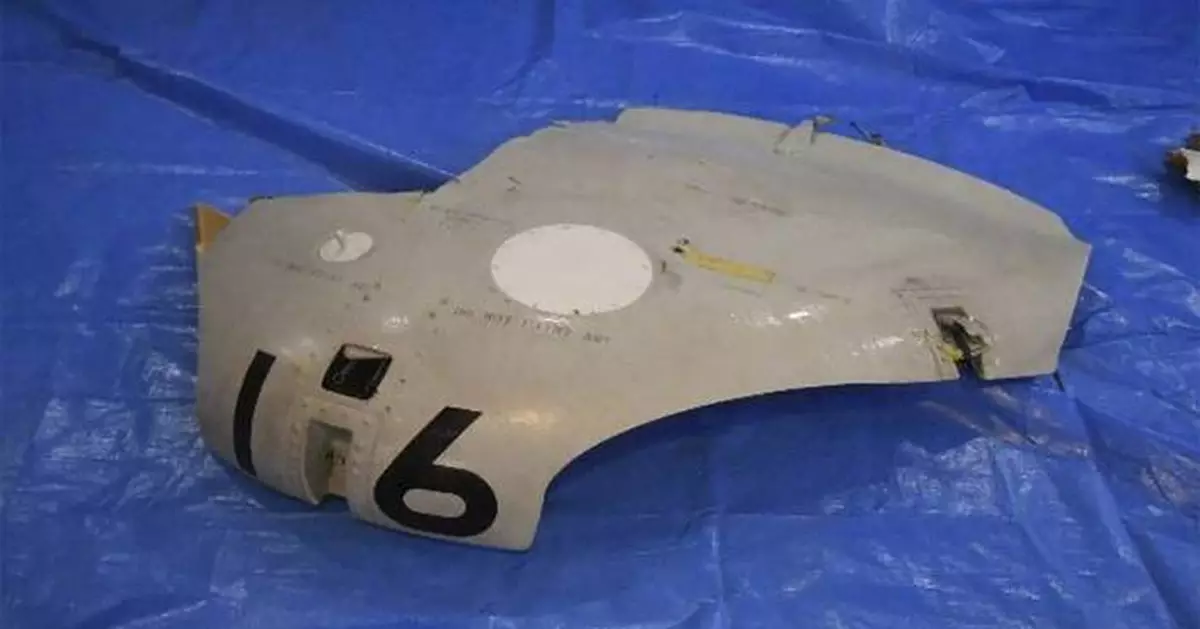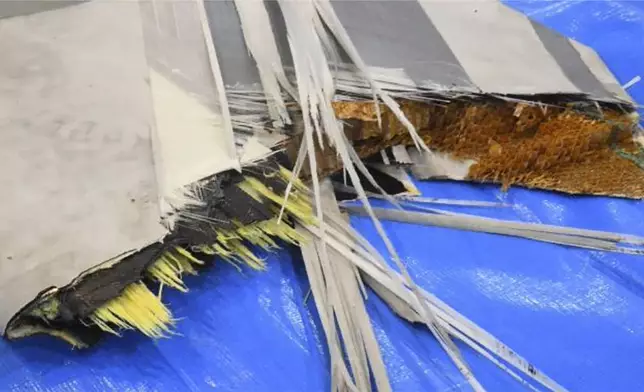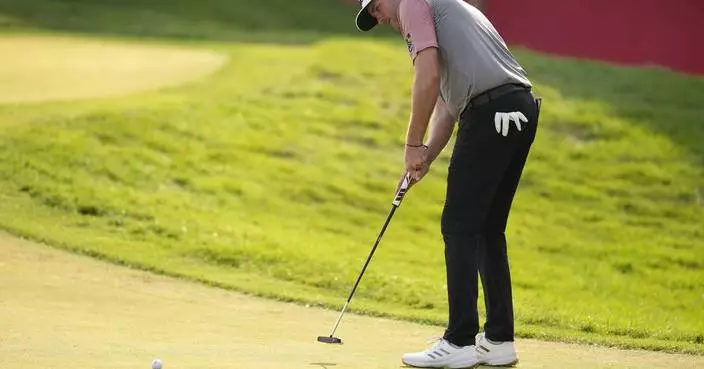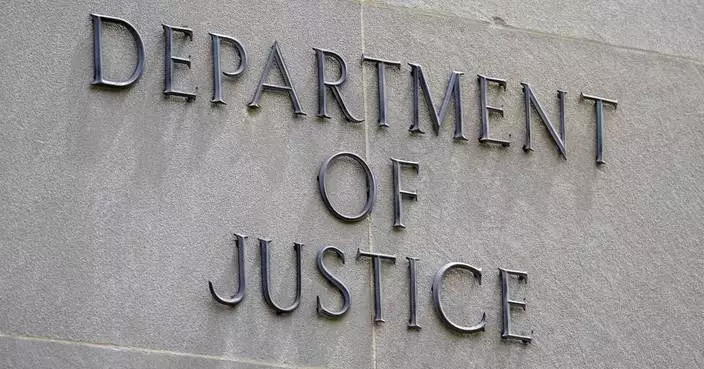TOKYO (AP) — An initial analysis of flight data recorders recovered from the crash of two Japanese navy helicopters showed no sign of mechanical problems, Japan’s defense minister said Monday, indicating likely human error. One of the eight crew members died and a search is continuing for the seven others.
Defense Minister Minoru Kihara said an initial analysis of data from the two flight data recorders on each helicopter showed no abnormality during their flight and that mechanical failure was most likely not the cause of the crash.
Click to Gallery
TOKYO (AP) — An initial analysis of flight data recorders recovered from the crash of two Japanese navy helicopters showed no sign of mechanical problems, Japan’s defense minister said Monday, indicating likely human error. One of the eight crew members died and a search is continuing for the seven others.
Japanese Defense Minister Minoru Kihara, left, and Japanese navy chief of staff Ryo Sakai, right, attend a press conference at Defense Ministry in Tokyo Monday, April 22, 2024. Initial analysis of flight data recorders recovered from the waters in the Pacific near the crash site of the two Japanese navy helicopters showed no sign that mechanical problems in the aircraft caused the accident, Japan’s defense minister said Monday, as he indicated human error. (Kyodo News via AP)
This image released by Japan Maritime Self-Defense Force shows the retrieved components which are believed to be a part of a crashed helicopter, Sunday, April 21, 2024. Initial analysis of flight data recorders recovered from the waters in the Pacific near the crash site of the two Japanese navy helicopters showed no sign that mechanical problems in the aircraft caused the accident, Japan’s defense minister said Monday, as he indicated human error. (Japan Maritime Self-Defense Force via AP)
This image released by Japan Maritime Self-Defense Force shows a retrieved component which is believed to be a part of a crashed helicopter, Sunday, April 21, 2024. Initial analysis of flight data recorders recovered from the waters in the Pacific near the crash site of the two Japanese navy helicopters showed no sign that mechanical problems in the aircraft caused the accident, Japan’s defense minister said Monday, as he indicated human error. (Japan Maritime Self-Defense Force via AP)
This image released by Japan Maritime Self-Defense Force shows a retrieved component which is believed to be a part of a crashed helicopter, Sunday, April 21, 2024. Initial analysis of flight data recorders recovered from the waters in the Pacific near the crash site of the two Japanese navy helicopters showed no sign that mechanical problems in the aircraft caused the accident, Japan’s defense minister said Monday, as he indicated human error. (Japan Maritime Self-Defense Force via AP)
The two SH-60K reconnaissance helicopters from the Maritime Self-Defense Force lost contact late Saturday during nighttime anti-submarine training near Torishima island, about 600 kilometers (370 miles) south of Tokyo, officials said.
A crew member who was recovered early Sunday from the water was later pronounced dead. Searches continued Monday for the seven who were still missing, along with the fuselage of the aircraft. The seabed at the crash site east of Torishima is about 5.5 kilometers (3.4 miles) deep and the recovery is considered a challenge.
Officials believe the two helicopters likely came too close and collided, Kihara said.
The flight data recorders from the two aircraft were found close together, along with a blade from each helicopter, a number of helmets and fragments believed to be from both aircraft — signs the two SH-60Ks crashed almost at the same spot, officials said.
The twin-engine, multi-mission helicopters developed by Sikorsky and known as Seahawks were modified and produced in Japan by Mitsubishi Heavy Industries. Japan has about 70 of the modified Seahawks.
The crash comes as Japan, under its 2022 security strategy, accelerates its military buildup and fortifies its defenses on southwestern Japanese islands in the Pacific and East China Sea to counter threats from China’s increasingly assertive military. Japan in recent years has conducted its own extensive naval exercises as well as joint drills with the United States and other partners.
Saturday’s nighttime anti-submarine warfare training involved only the Japanese navy, navy chief of staff Ryo Sakai said.
In 2017, a Japanese navy SH-60J, an earlier generation Seahawk, crashed during nighttime training due to human error, killing three crew. In July 2021, two SH-60s had a minor collision off the southern island of Amami Oshima, with both suffering blade damage, but causing no injuries.
Following the 2021 collision, the navy introduced a set of measures aimed at ensuring enough distance between aircraft. Sakai said Saturday’s crash could have been prevented if all safety measures had been adequately followed.
In the U.S., the fatal crash of a MH-60S Seahawk during training off the coast of California in 2021 was attributed to mechanical failure from unsuspected damage during maintenance, according to the U.S. Navy.
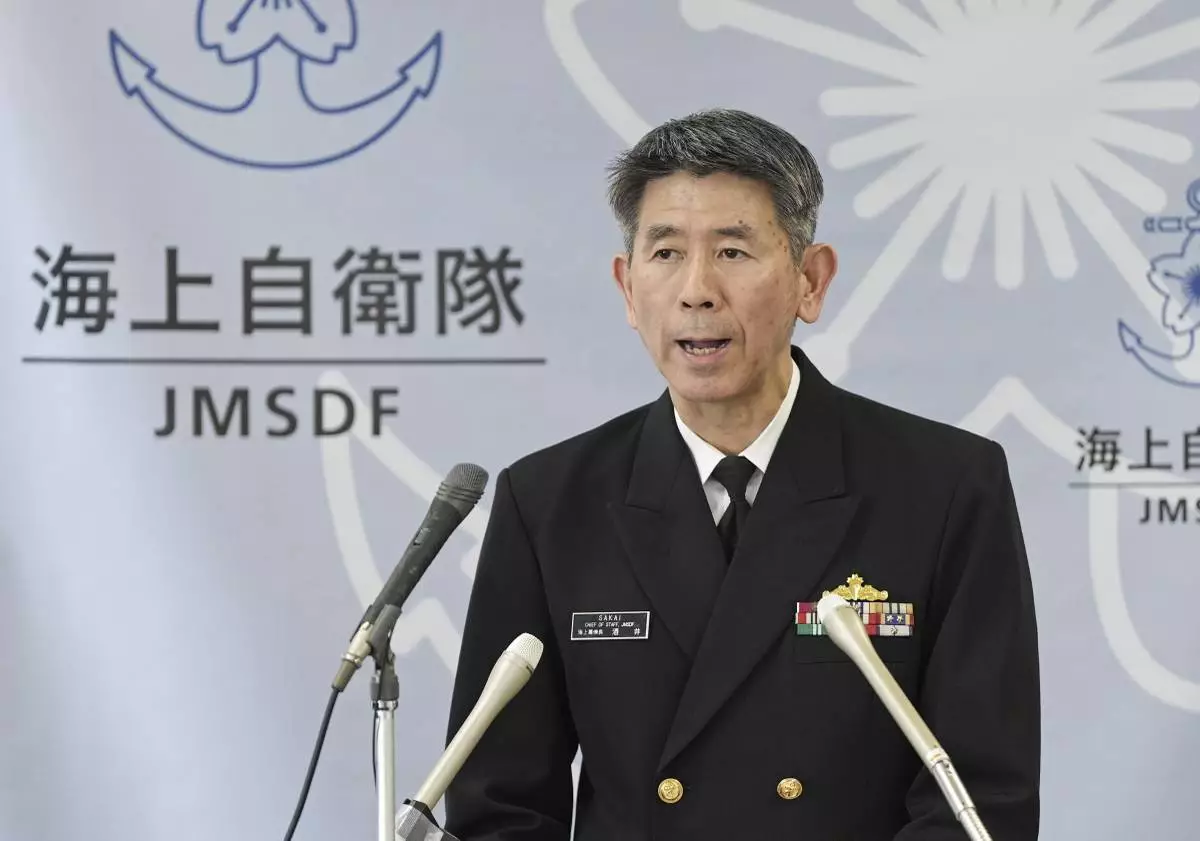
Japanese navy chief of staff Ryo Sakai speaks during a press conference at Defense Ministry in Tokyo Sunday, April 21, 2024. Initial analysis of flight data recorders recovered from the waters in the Pacific near the crash site of the two Japanese navy helicopters showed no sign that mechanical problems in the aircraft caused the accident, Japan’s defense minister said Monday, as he indicated human error. (Kyodo News via AP)
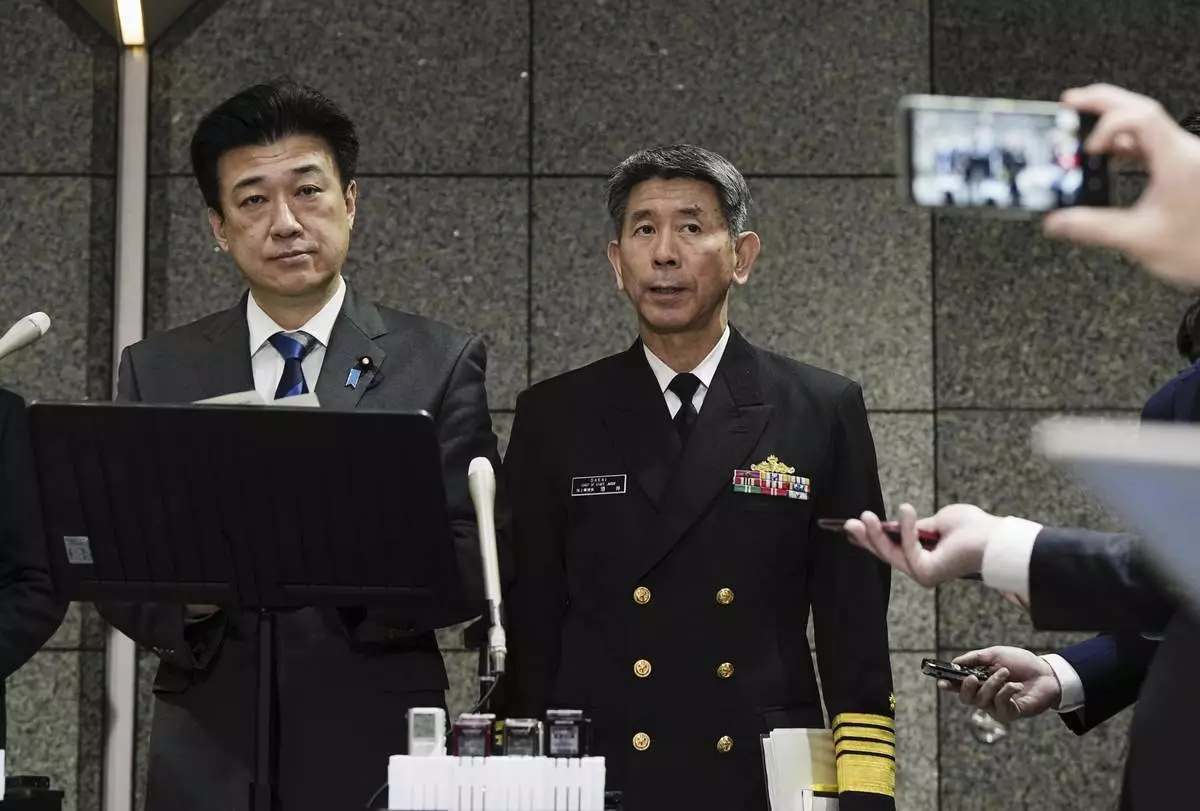
Japanese Defense Minister Minoru Kihara, left, and Japanese navy chief of staff Ryo Sakai, right, attend a press conference at Defense Ministry in Tokyo Monday, April 22, 2024. Initial analysis of flight data recorders recovered from the waters in the Pacific near the crash site of the two Japanese navy helicopters showed no sign that mechanical problems in the aircraft caused the accident, Japan’s defense minister said Monday, as he indicated human error. (Kyodo News via AP)
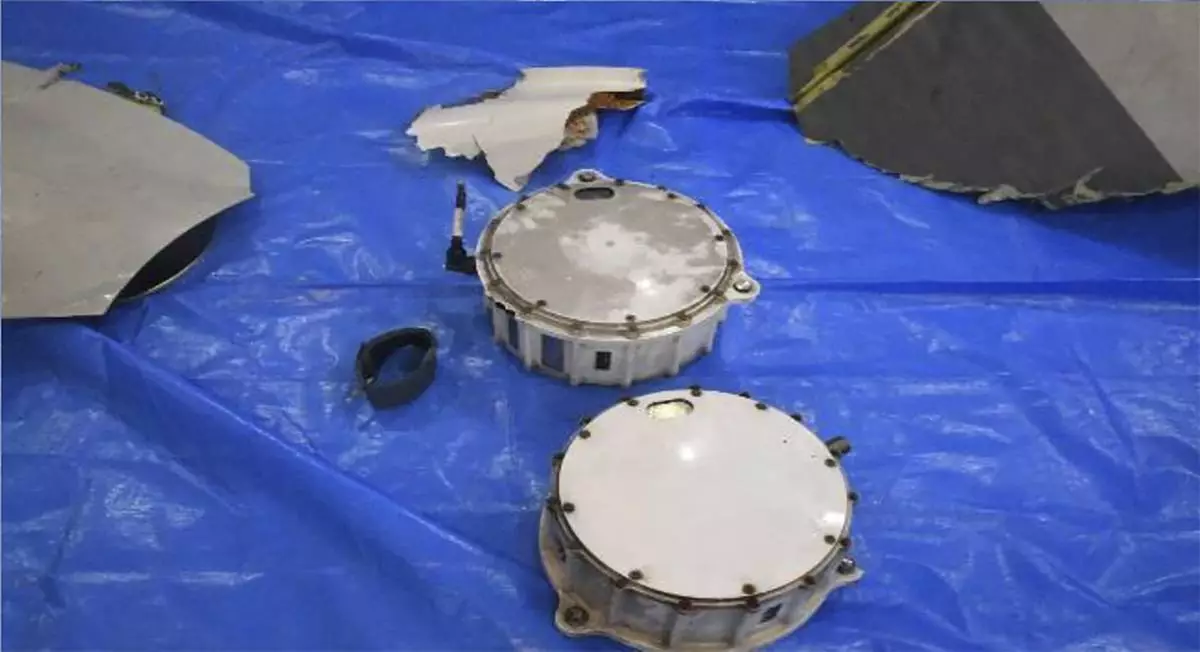
This image released by Japan Maritime Self-Defense Force shows the retrieved components which are believed to be a part of a crashed helicopter, Sunday, April 21, 2024. Initial analysis of flight data recorders recovered from the waters in the Pacific near the crash site of the two Japanese navy helicopters showed no sign that mechanical problems in the aircraft caused the accident, Japan’s defense minister said Monday, as he indicated human error. (Japan Maritime Self-Defense Force via AP)

This image released by Japan Maritime Self-Defense Force shows a retrieved component which is believed to be a part of a crashed helicopter, Sunday, April 21, 2024. Initial analysis of flight data recorders recovered from the waters in the Pacific near the crash site of the two Japanese navy helicopters showed no sign that mechanical problems in the aircraft caused the accident, Japan’s defense minister said Monday, as he indicated human error. (Japan Maritime Self-Defense Force via AP)
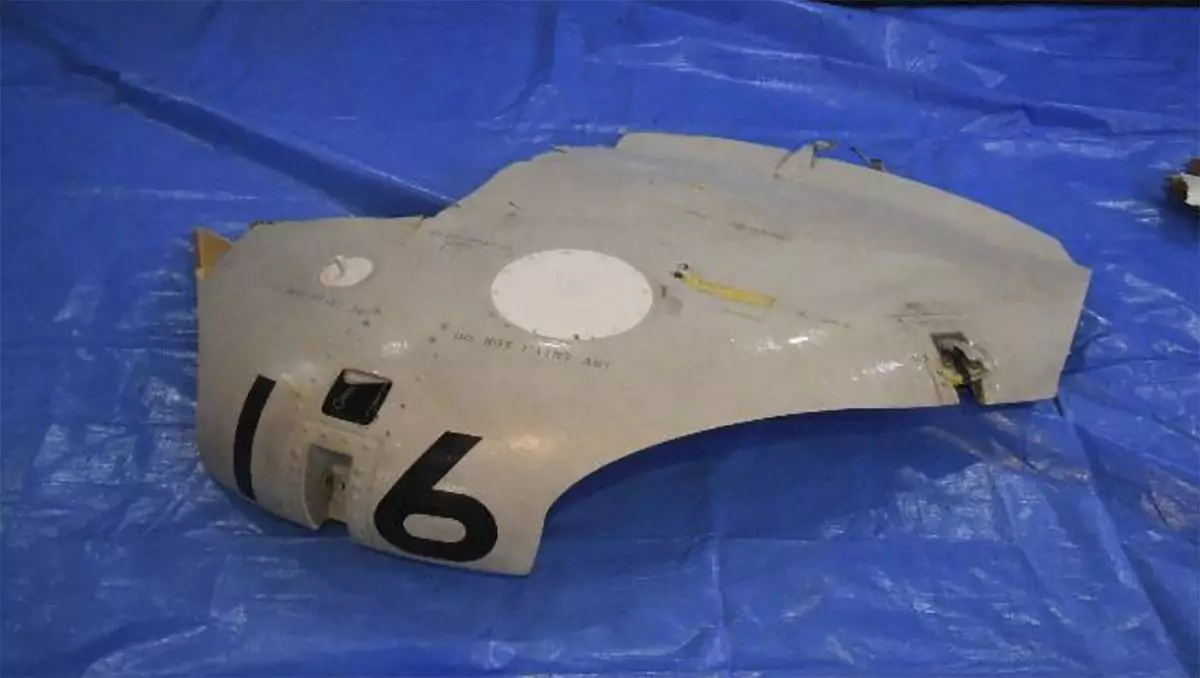
This image released by Japan Maritime Self-Defense Force shows a retrieved component which is believed to be a part of a crashed helicopter, Sunday, April 21, 2024. Initial analysis of flight data recorders recovered from the waters in the Pacific near the crash site of the two Japanese navy helicopters showed no sign that mechanical problems in the aircraft caused the accident, Japan’s defense minister said Monday, as he indicated human error. (Japan Maritime Self-Defense Force via AP)
NEW YORK (AP) — Kodai Senga's injury-delayed season debut for the New York Mets was cut short after 5 1/3 innings and 73 pitches when he strained his left calf while pitching against the Atlanta Braves on Friday night.
After inducing Austin Riley to pop up leading off the sixth, Senga pointed toward Pete Alonso and began sprinting off the mound to clear room for the first baseman. The 31-year-old right-hander grabbed his left calf and bounced for a couple steps before falling.
Senga held his calf as he was surrounded by catcher Francisco Alvarez, manager Carlos Mendoza, his interpreter and an athletic trainer. Senga and the trainer rubbed Senga’s calf before Senga got up, exchanged hugs and handshakes with teammates on the infield and limped off.
Senga, who missed the first 102 games with a right shoulder capsule strain, allowed just two hits — including Adam Duvall’s two-run homer in the second inning — while striking out nine. He retired his final 10 batters.
Runner-up to Arizona's Corbin Carroll for NL Rookie of the Year last season, Senga was 12-7 with a 2.98 ERA in 29 starts after signing a $75 million, five-year contract.
Senga began a minor league injury rehabilitation assignment on July 3 and went 0-0 with a 4.15 ERA in four starts, three for Triple-A Syracuse and one for Class A Brooklyn.
Right-handed reliever Eric Orze was recalled from Triple-A Syracuse and emerging reliever Dedniel Núñez was put on the 15-day injured list with a right pronator strain. Right-handers Adrian Houser and Shintaro Fujinami were designated for assignment.
Núñez, 2-0 with a 2.43 ERA and one save in 24 games, had an MRI that didn't reveal any elbow ligament damage, manager Carlos Mendoza said. The 28-year-old right-hander began feeling tightness following back-to-back appearances at Miami last Saturday and experienced discomfort again Wednesday,
Houser, acquired from Milwaukee with outfielder Tyrone Taylor on Dec. 20, was 1-5 with a 7.84 ERA and one save in seven starts and 16 relief appearances. He opened 0-3 with an 8.16 ERA in his first six starts before working himself into a late-inning bullpen role by going 1-1 with a 2.84 ERA in 12 appearances from May 10 through June 30.
Hauser was scored upon in all five of his outings this month with a 9.00 ERA.
“Even when we put him in the bullpen, he was always willing to take the baseball and do whatever the team needed,” Mendoza said. “He was such a professional. It was just hard for him to find that consistency.”
Fujinami signed to a $3.35 million, one-year deal and opened the season with Syracuse. He was recalled and placed on the 15-day injured list on May 13 with a strained right shoulder, then walked eight in 8 2/3 innings over nine rehab appearances since June 25.
AP MLB: https://apnews.com/hub/mlb

New York Mets' Kodai Senga, right, high-fives Luis Severino while walking into the dugout during the fourth inning of a baseball game against the Atlanta Braves, Friday, July 26, 2024, in New York. (AP Photo/Pamela Smith)

New York Mets' Kodai Senga gestures while walking into the dugout during the fourth inning of a baseball game against the Atlanta Braves, Friday, July 26, 2024, in New York. (AP Photo/Pamela Smith)

New York Mets' Kodai Senga (34) reacts as he leaves the field due to an injury during the sixth inning of a baseball game against the Atlanta Braves, Friday, July 26, 2024, in New York. (AP Photo/Pamela Smith)

New York Mets' Kodai Senga grabs his leg as he reacts to an injury during the sixth inning of a baseball game against the Atlanta Braves, Friday, July 26, 2024, in New York. (AP Photo/Pamela Smith)







